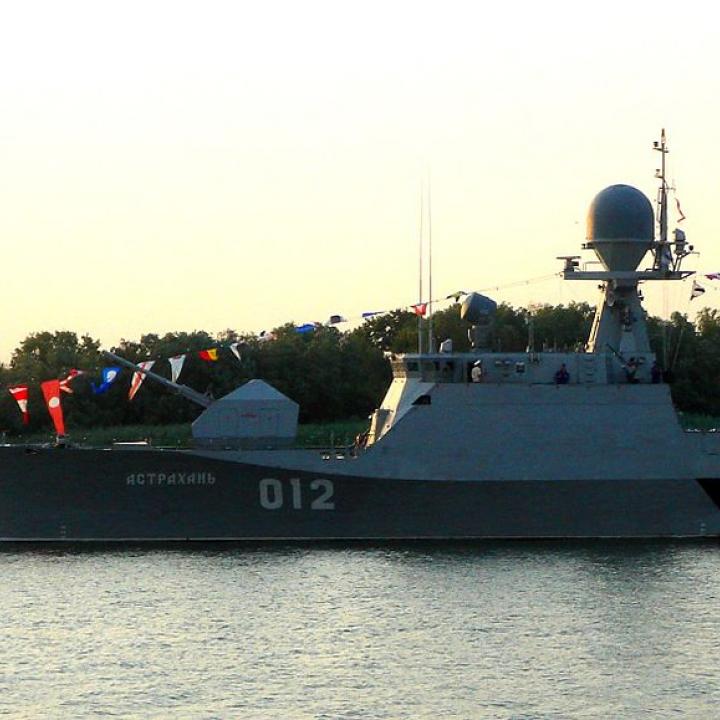
- Policy Analysis
- Policy Alert
Russia's Cruise Missiles Raise the Stakes in the Caspian

The missile strikes on targets in Syria showed unprecedented cooperation between Russia and Iran, but they also serve as a wakeup call to Tehran about Moscow's expanding military profile in the Caspian.
On October 7, the Russian Defense Ministry announced that its warships had fired twenty-six cruise missiles from the central Caspian Sea at eleven targets (reportedly ISIS elements) in Raqqa, Idlib, and Aleppo, about 1,500 kilometers away and deep within Syrian territory. The incident established two precedents that could hold wider implications for the war and the regional security situation in general: it is the first time in modern history that shots have been fired in anger from the Caspian Basin, and it also marks the first use of cruise missiles in the Syrian war, at least by the regime's side.
The missiles were fired by the Russian navy's Caspian Flotilla, created almost three centuries ago by Peter the Great. Among the flotilla's warships are one Gepard-class (Project 11661K) frigate (the Dagestan, hull number 693) and three Buyan-M class corvettes (Grad Sviyazhsk 021, Uglich 022, and Veliki Ustyug 106). Each has eight vertical launching system (VLS) cells capable of firing 3M-14T Kalibr NK (Klub-N) land-attack cruise missiles with a maximum range of 2,500 kilometers. This gives Russia the capability to fire up to thirty-two such missiles from the Caspian in quick succession. It also suggests that as many as six missiles might have failed to reach their targets on Wednesday -- a speculation confirmed by the latest Pentagon revelation and by local Iranian media reports that at least four missiles had crashed in Iran, with their wreckage recovered by Iranian authorities.
On their way to their targets in Syria, the missiles flew over northwestern Iran and Iraqi Kurdistan, reportedly sticking to uninhabited territory. Moscow sought permission from each country before firing; the Defense Ministry stated that the operation was coordinated with allies, and that targeting intelligence was provided by "satellites, drones, local sources, Iraq, and Iran."
Compared to weapons previously used in Syria, the Russian cruise missiles offer extensive explosive power -- almost 26,000 pounds/11,700 kilograms when combining the total weight of the warheads -- with great accuracy and low risk to operators. Yet in this case it remains to be seen whether any civilian collateral damage was caused.
The 3M-14T spends most of its flight path at subsonic speeds around 15 meters above the surface, and makes a supersonic dash to the target in its final phase. It is guided using inertial and satellite (GLONASS and GPS) navigation, with an active radar seeker taking over at 20 kilometers from the target if it has sufficient radar contrast. Russian Defense Ministry sources claimed that targets were struck with an accuracy of 3 to 5 meters.
While the operation shows an unprecedented level of military cooperation between Iran and Russia in their fight to sustain Bashar al-Assad, it also shows shifting geopolitical fault lines in the wider region. As recently as 2011, Russia and Kazakhstan were conducting exercises aimed at defending their joint Caspian interests against potential Iranian attacks. Wednesday's strikes are also a wakeup call for Iran, showing that Russia has raised the stakes in the Caspian and now has proven long-range land-attack systems that can reach anywhere in Iran or the Persian Gulf. This could prompt Tehran to place its own Soumar cruise missiles (with similar range) on its Caspian shores, or even mount them on newer warships planned to be built at the Anzali shipyard, further increasing the regional arms race. Given Russia's use of the Caspian in such a high-profile military operation, and its willingness to keep substantial military assets there, Iran may decide that it needs to deploy more of its own assets to the area as well. Moscow has never allowed Iran to transfer naval vessels to its 4th Naval District's Caspian bases using the Volga-Don Shipping Canal, which passes through Russian territory. This prohibition has prompted Iran to build missile boats and frigates directly on the Caspian coast.
More broadly, while Iran and Russia have cooperated in the past to curb the U.S. and NATO presence in the region, Iran has also been wary of an increased Russian military presence there -- though it has been careful not to voice such concerns publicly. In the past, Iran's official position was that deploying military forces in the Caspian would be unconstructive to regional security and the common interests of the littoral states, which have yet to agree on a legal regime delimiting their maritime boundaries.
Farzin Nadimi is a Washington-based analyst specializing in the security and defense affairs of Iran and the Persian Gulf region.



